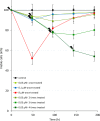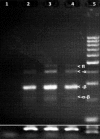Telomere shortening in breast cancer cells (MCF7) under treatment with low doses of the benzylisoquinoline alkaloid chelidonine
- PMID: 30281650
- PMCID: PMC6169906
- DOI: 10.1371/journal.pone.0204901
Telomere shortening in breast cancer cells (MCF7) under treatment with low doses of the benzylisoquinoline alkaloid chelidonine
Abstract
Telomeres, the specialized dynamic structures at chromosome ends, regularly shrink with every replication. Thus, they function as an internal molecular clock counting down the number of cell divisions. However, most cancer cells escape this limitation by activating telomerase, which can maintain telomere length. Previous studies showed that the benzylisoquinoline alkaloid chelidonine stimulates multiple modes of cell death and strongly down-regulates telomerase. It is still unknown if down-regulation of telomerase by chelidonine boosts substantial telomere shortening. The breast cancer cell line MCF7 was sequentially treated with very low concentrations of chelidonine over several cell passages. Telomere length and telomerase activity were measured by a monochrome multiplex quantitative PCR and a q-TRAP assay, respectively. Changes in population size and doubling time correlated well with telomerase inhibition and telomere shortening. MCF7 cell growth was arrested completely after three sequential treatments with 0.1 μM chelidonine, each ending after 48 h, while telomere length was reduced to almost 10% of the untreated control. However, treatment with 0.01 μM chelidonine did not have any apparent consequence. In addition to dose and time dependent telomerase inhibition, chelidonine changed the splicing pattern of hTERT towards non-enzyme coding isoforms of the transcript. In conclusion, telomere length and telomere stability are strongly affected by chelidonine in addition to microtubule formation.
Conflict of interest statement
The authors have declared that no competing interests exist.
Figures






References
-
- Rhodes D, Giraldo R. Telomere structure and function. Curr Opin Struct Biol. 1995; 5: 311–322. - PubMed
Publication types
MeSH terms
Substances
LinkOut - more resources
Full Text Sources
Medical

